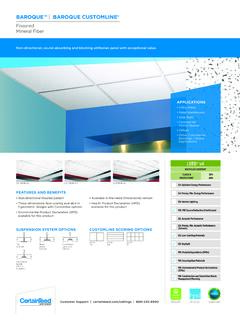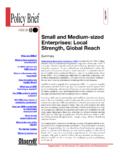Transcription of Community capacity building: fostering economic and social ...
1 Please cite this paper as: OECD/Noya A. Clarence E., Community capacity building: fostering economic and social resilience. Project outline and proposed methodology , 26-27 November 2009, working document, CFE/LEED, OECD, . OECD LEED Programme Community capacity building: fostering economic and social resilience PROJECT OUTLINE AND PROPOSED METHODOLOGY Antonella Noya and Emma Clarence CFE/LEED(2009)21 2 TABLE OF CONTENTS Introduction .. 3 Context .. 3 Some key lessons for policy makers.
2 4 Some areas to be explored .. 7 Methodology: Project outline and review framework .. 8 Objectives .. 8 Detailed stages of the project .. 8 Timing .. 10 Budget .. 10 Bibliography .. 11 Figures Figure 1. Community capacity Building - Local Multiplier Effect (combining social and economic factors) .. 5 Boxes Box 1. Gellideg Foundation Group Gellideg, Wales (UK) .. 6 Box 2. Palmas Bank Brazil .. 7 Box 3. Brief overview of review activities .. 10 This note presents the proposed methodology for a project on Community capacity Building: fostering economic and social Resilience [CFE/LEED(2009)21], prepared as a follow-up to the discussion held at the 54th session of the LEED Directing Committee in May 2009 on the draft report on Community capacity Building [CFE/LEED(2009)10].
3 CFE/LEED(2009)21 3 Introduction 1. Community capacity building (CCB) focuses on enabling all members of the Community , including the poorest and the most disadvantaged, to develop skills and competencies so as to take greater control of their own lives and also contributes to inclusive local development. Not only can communities be more cohesive but they can also be more resilient and better placed to confront economic and social challenges. Meaningful and effective Community capacity building can be stimulated and fostered by national and local governments, and by the capacity which communities have already developed, so that power becomes increasingly embedded within them.
4 2. CCB has developed as a concept because of the need for strategies to address major social and economic decline in towns, cities and regions experiencing significant economic change and the consequences of deep-seated and long term worklessness and benefits dependency. 3. Following the OECD study on Community capacity Building (presented and approved at the 52nd LEED Directing Committee and published in 2009 as Community capacity Building: Creating a Better Future Together), further ideas are presented here as to how to extend and embed its analysis into a broader programme of work.
5 4. This document presents, in detail, a project of work on Community capacity Building: fostering economic and social Resilience , its methodology, objectives and outputs. The specific focus of the project is to enhance local and national governments capacity to design and implement strategies to build, rebuild and sustain Community capacity especially in deprived communities and in towns, cities and regions suffering from economic decline, worklessness and benefits dependency.
6 To this end the project will identify the current approaches to CCB, the obstacles to designing effective CCB strategies, together with the drivers to more effective empowerment at local level. Emphasis will also be put on the skills and institutions needed in a Community to actively build or rebuild local social and economic life. Recommendations will be developed and international examples of good practice ( learning models ) will be provided. Context 5. Today the developed world is faced with a new wave of industrial change remaining industrial centres in Western Europe and North America are threatened with the same decline experienced by similar towns and cities twenty to thirty years ago.
7 The financial crisis and global recession will see, and are already witnessing, restructured companies closing large industrial facilities and other major employment sites; car plants are likely to close in cities in the US, France, Belgium, Italy, Spain, Portugal, Germany and the UK; major steel production centres are under threat in the UK, Belgium, Germany and Scandinavia. These developments are often combined with steady economic decline. Many towns, cities and regions are still looking for new types of economic purpose in the future; new specialisms, greater diversification, new forms of entrepreneurship.
8 There is a danger that the most fragile locations in the developed and developing world are bearing a disproportionate brunt of the global slowdown. Unemployment and business closures are rising fastest in those areas of the advanced world where worklessness and low business activity were already problematic. Furthermore, localities emerging from political conflict and division often remain fragile for generations. Poverty, exclusion and worklessness are inherent in affected communities and exacerbated at times of economic downturn.
9 6. Such realities are a central part of the rationale for continuing and expanding the work on Community capacity building. There are many areas (from the neighbourhood to the country level) that require economic and social strategies that enable them to build, or to continue rebuilding local CFE/LEED(2009)21 4 communities and economies. Indeed, for some years to come it will be necessary to preserve Community capacity and assets in order to maintain social and economic conditions.
10 At the same time, there are also places where capacity building strategies can help to build economic and social assets during longer term growth phases. By building capacity , communities will be in a better position to meet the challenges of the current crisis and to be more resilient to the next economic downturn. Better jobs, increased levels of entrepreneurship, positive social capital indicators, business performance and sustainability are all potential indicators of the resilience which increased Community capacity can bring to local areas.

















